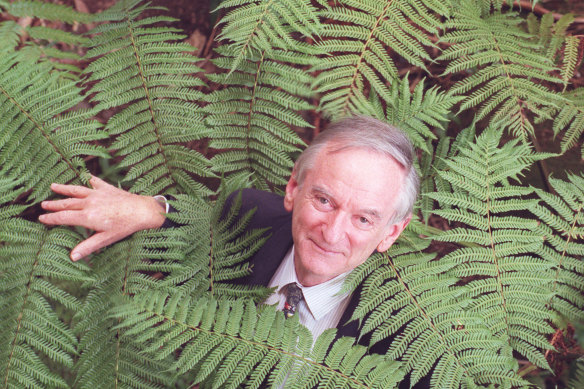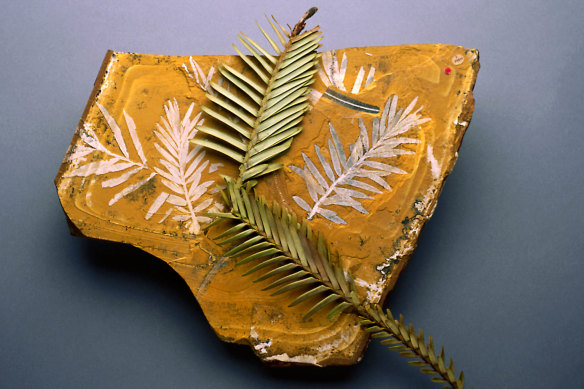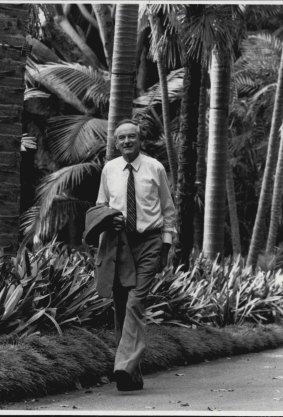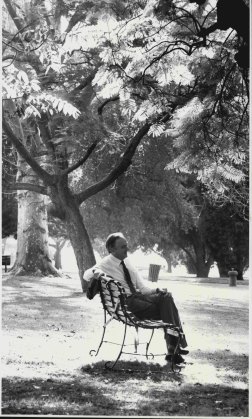Botanist identified Wollemi Pine as ‘Jurassic Park’ brought to life
By Malcolm Brown
CARRICK CHAMBERS: 1930 - 2023
Carrick Chambers, shown an odd piece of conifer brought to him at the Royal Botanic Garden Sydney in 1994, drawing on his research experience years earlier, thought it might be the living descendant of a conifer that had previously been seen in 110-year-old fossils.
That started a process of inquiry that brought the Wollemi Pine to world attention. The tree, found in a small canyon in the Wollemi National Park 200 kilometres from Sydney, had somehow survived the huge climatic changes and seismic shifts that had occurred since the Cretaceous era.

Carrick Chambers at the Royal Botanic Garden among some of his much-loved tree ferns.Credit: Fairfax
Once studied by other experts and its identify confirmed, the conifer was named after the place it was discovered and revealed to the world, and subsequently became a sensation. It was, Chambers said, “the botanical equivalent of finding a small dinosaur still alive on Earth.”
This was a high point in an illustrious life of a gentle man, a man devoted to the plants and trees and the beauty of the natural environment, seeing its importance beyond the petty concerns of the world around him. His family was to say in a tribute that he was “often oblivious to dangers of some of the places he visited … he was happy to take local buses in Caracas and to wander around the Bronx in New York as he navigated various botanical gardens and parks, always smartly dressed with a suit and tie and always finding people of interest along the way”.

A fossil with pieces of Wollemi pine.
Chambers’ legacy would be major developments in botanical life and the environment wherever he went, including Sydney’s Royal Botanic Garden, which he headed as director for 10 years. It might be appropriate to quote Handel’s aria Where’er You Walk: “And all things flourish. Where’er you turn your eyes …”
Thomas Carrick Chambers was born on September 5, 1930, in Auckland, New Zealand, son of a professional photographer and keen gardener, Thomas Chambers, and Lyda (nee Higgott). During the Great Depression, his father and mother rented a shop, running it as stationery store and lending library.
The young Chambers demonstrated an early interest in botany and at age 10 was working as a nurseryman. In the war years, he was a student at the Agricultural (Otahuhu Technical) College in Auckland, his studies interspersed with vegetable harvesting for the war effort. Turning down the option of teaching, he went to Auckland University College, paying his way by working at a freezing works, on wharves and as a plumber’s assistant.

Carrick Chambers in the palm garden at the Royal Botanic Garden Sydney in 1986.Credit: Fairfax
Chambers graduated as a master of science in 1954, taught at the college for a year, then in 1956 took a teaching fellowship at the Sydney University. In 1958, he joined the CSIRO and in 1959 married Margaret Davis, whom he had met as a student at the university. He completed a PhD in 1960 and was awarded a CSIRO overseas postgraduate studentship at Cambridge, where he trained in electron microscopy in the botany school and the Cavendish Laboratory, riding on the wave of new biological knowledge which included the unravelling of the structure of DNA. He and his wife returned to Australia in 1961, where Chambers took a position at the botany department at Melbourne University.
Chambers’ life and career took off and twins, the first of four children, were born in 1962. In 1967 he became one of the university’s youngest professors, later chairing the botany department, and took his studies into a range of fields, including electron microscopy, genetics, taxonomy and palaeontology.
By the 1980s the department was one of the largest teaching-research botany facilities in the Commonwealth. His interest was not restricted to plants themselves but in how they were presented and how they could contribute to the environment aesthetically, even spiritually. Finding the Melbourne University grounds “scungy, at best”, he joined and chaired the university’s grounds committee, laying out programs to re-landscape the entire campus.
Chambers went on to sit on and chair many trusts and committees, consulting on such things as the gardens at Government House and the Melbourne Club. He was involved in the land transfer from Boral Ltd, which became the Royal Botanic Gardens, Cranbourne. And was part of establishing the Potter Farmland Plan to restore over-cleared land and declining farmland. That plan promoted using native plants to reduce erosion and boost productivity. It became the international program Landcare. When the Melbourne University senate proposed the demolition of the old physics building, he staged what was described as a “one-man tantrum” in opposition.

Carrick Chambers during his time director of the Royal Botanic Garden, during a tour of the gardens, 1986.Credit: Fairfax
In 1986, Chambers and his wife relocated to Sydney, where he was appointed director of the Royal Botanic Garden, succeeding Dr Lawrie Johnson. He built on Johnson’s success by building the tropical centre and fernery and adding specialist gardens for herbs, ferns, roses, begonias and oriental plants, and initiated career pathways for horticulturalists, which became a model for other botanical gardens.
Chambers oversaw the opening and development of the Blue Mountains Botanic Garden Mount Tomah – formerly a cut-flower farm – and the Australian Botanic Garden Mount Annan, formerly farmland. He also helped establish new gardens in the Hunter Valley, Orange and Taree, and saw the botanical potential of just about any other slice of countryside. He said in 1991. “If there are no new trees in a landscape, that landscape is dying. Tree cover in rural areas, against forestry areas, is becoming seriously depleted. Some vast tracts of countryside the inland slopes have no trees regenerating.”
In 1994, a National Parks and Wildlife Service field officer, David Noble, turned up after a week’s canyoning at the Wollemi National Park, with his unusual conifer specimen. Staff suggested he should show it to Chambers, who recognised it as possibly something he and a graduate student, Andrew Drinnan, had documented and classified in the 1970s from Cretaceous era sediments in the Gippsland Basin.
He asked for better specimens and cones and summoned Drinnan to give his opinion. Other experts joined in, and it became increasingly clear that this was a new living species. The identification was done by botanists Wyn Jones, Ian Allen and Ken Hill. Articles were published, and it was taken up by the International Journal of Plant Sciences. Global interest was aroused: it was Jurassic Park brought into reality. The plant was propagated and its survival assured. A foremost Australian botanist, Dr Barbara Briggs, said: “On the world scene, it’s one of the most outstanding (botanical) discoveries of a century”. On December 14, 1994, Wollemia nobilis was declared a new genus, the name “nobilis” selected to honour the national parks officer who had made the discovery.
In 1996, Chambers retired and was appointed an honorary research associate at the National Herbarium of New South Wales to continue fern research. In 1998, he was awarded an AM for “service to botany and its application to horticulture as Director of Royal Botanic Garden and Domain, Sydney, and as a teacher and researcher on conservation issues and botanical concepts”.
His interests continued in his later years. In 2019, he published his last scientific paper, with a colleague, Dr Peter Wilson, after researching the taxonomy of Blechnum ferns.
Chambers died on July 31 and his funeral was held at Cremorne on August 9. He is survived by wife Margaret, children Michael, Daryl, John and Claudia, and six grandchildren.
The Morning Edition newsletter is our guide to the day’s most important and interesting stories, analysis and insights. Sign up here.